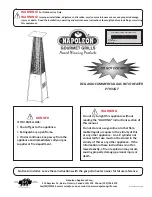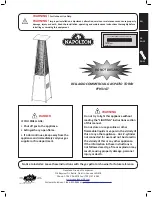
Special note on propane fuel:
DANGER
Explosion Hazard
To clear accumulated LP gas before attempt-
ing to light or re-light pilot:
• Open burner door by loosening the two
mounting screws and pulling door back
approximately 1/2” away from combustion
chamber.
• Allow ventilation of combustion chamber
for ten minutes.
• Close burner door. Refer to warning
below.
Failure to do so can result in death,
explosion, or fire.
L.P. GAS IS HEAVIER THAN AIR
Should there be a leak in the system, the gas will settle
at FLOOR LEVEL. Basements, crawl spaces, closets and
areas below ground level will serve as pockets for the accu-
mulation of the gas.
Out of fuel
When your L.P. tank runs out of fuel, turn off gas at all gas
appliances. After L.P. tank is refilled, all appliances must be
re-lit according to the manufacturers instructions.
Water Temperature Regulation
DANGER
Valves for reducing the point-of-use temperature by mixing
cold and hot water are available. Also available are inex-
pensive devices that attach to faucets to limit hot water tem-
peratures. Contact a licensed plumber or the local plumbing
authority.
The thermostat is adjusted to the pilot position when it is
shipped from the factory. Water temperature can be regulat-
ed by moving the temperature dial to the preferred setting.
The preferred starting point is 49°C (120°F) at the “HOT”
setting. Align the knob with the desired water temperature
as shown in Figure 26. There is a hot water scald potential
if the thermostat is set too high.
Note:
Temperatures shown on the gas control valve/thermo-
stat are approximates. The actual temperature of the heated
water may vary.
Important:
Adjusting the thermostat past the 49°C (120°F)
mark on the temperature dial will increase the risk of scald
injury. Hot water can produce first degree burns within:
Water
Temperature
°C (°F)
Time for 1st Degree
Burn (Less Severe
Burns)
Time for Permanent
Burns 2nd & 3rd Degree
(Most Severe Burns)
43 (110)
(normal shower temp.)
47 (116)
(pain threshold)
47 (116)
35 minutes
45 minutes
50 (122)
1 minute
5 minutes
55 (131)
5 seconds
25 seconds
60 (140)
2 seconds
5 seconds
65 (149)
1 second
2 seconds
154
instantaneous
1 seconds
U.S. Government Memorandum, C.P.S.C., Peter L. Armstrong,
Sept. 15,1978
GAS CONTROL VALVE/THERMOSTAT
SETTINGS
GAS CONTROL/
TEMPERATURE KNOB
STATUS
LIGHT
IGNITER
49°C
(120°F)
55°C
(130°F)
68°C
(155°F)
66°C
(150°F)
60°C
(140°F)
33°C
(91°F)
Figure 26 - Gas Control Valve/Thermostat Settings
Should overheating occur or the gas supply fail to shut off,
turn off the manual gas control valve to the appliance.
Note:
During low demand periods when hot water is not
being used, a lower thermostat setting will reduce energy
losses and may satisfy your normal hot water needs. If hot
water use is expected to be more than normal, a higher
thermostat setting may be required to meet the increased
demand. When leaving your home for extended periods
(vacations, etc.) turn the temperature dial to its lowest set-
ting. This will maintain the water at low temperatures with
minimum energy losses and prevent the tank from freezing
during cold weather.
– 13 –









































